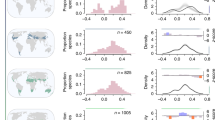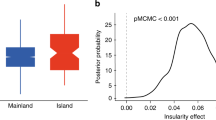Abstract
Birds have brains that are comparable in size to those of mammals. However, variation in relative avian brain size is greater in birds. Thus, birds are ideal subjects for comparative studies on the ecological and behavioral influences on the evolution of the brain and its components. Previous studies of ecological or behavioral correlates in relative brain size were mainly based on gross comparisons between higher taxa or focussed on the relationships between the sizes of specific brain structures and the complexity of different tasks. Here we examine variation in dimensions of the braincase, relative overall brain size and size of its components, in reference to one general ecological and behavioral task: migration. We used data from three lineages of closely related species (14 Acrocephalines, 17 Sylvia and 49 parulid warblers). Within each group, species vary in their migratory tendencies. We found that species migrating long distances have lower skulls and smaller forebrains than resident species. We discuss four hypotheses that could explain smaller forebrain sizes, and suggest relevant taxa to use in comparative analyses to examine each of these hypotheses:
-
Brain size is energetically constrained. Contrasts can be made not only between migrants and residents, but also between birds in habitats with high and low levels of available food.
-
Brain size is developmentally constrained; birds with short growing periods should have smaller forebrains. Comparisons need to be made between birds living in habitats with long and short breeding seasons.
-
Bill adaptations for foraging constrain braincase dimensions. Further analyses would need to be done on groups with high variation in bill dimensions and foraging modes.
-
Birds with small brains have to migrate to compensate for low behavioral flexibility. Contrasts between members of families containing tropical residents and migrants need to be made.
We also raise the question of whether only those parts of the brain are reduced that are most dispensable and whether brain size reduction limits foraging skills and social competence.


Similar content being viewed by others
References
Abbott ML, Walsh CJ, Storey AE, Stenhouse LJ, Harley CW (1999) Hippocampal volume is related to complexity of nesting habitat in Leach’s storm petrel, a nocturnal procellariiform seabird. Brain Behav Evol 53:271–276
Alerstam T, Hedenström A (1998) The development of bird migration theory. J Avian Biol 29:343–369
Armstrong E, Bergeron R (1985) Relative brain size and metabolism in birds. Brain Behav Evol 26:141–153
Austen MJW (1988) Ecomorphology of North American wood warblers. MSc Thesis University of Western Ontario, London, Ontario
Barker FK, Barrowclough GF, Groth JG (2001) A phylogenetic hypothesis for passerine birds: taxonomic and biogeographic implications of an analysis of nuclear DNA sequence data. Proc R Soc Lond B 269:295–308
Beecher WJ (1978) Feeding adaptations and evolution in the starlings. Bull Chicago Acad Sci 11:269–298
Bennett PM, Harvey PH (1985) Relative brain size and ecology in birds. J Zool 207:151–169
Berthold P (1999) A comprehensive theory for the evolution, control and adaptability of avian migration. Ostrich 70:1–11
Boire D, Baron G (1994) Allometric comparison of brain and main brain subdivisions in birds. J Brain Res 35:49–66
Brooke MD, Hanley S, Laughlin SB (1999) The scaling of eye size with body mass in birds. Proc R Soc Lond B 266:405–412
Burish MJ, Kueh HY, Wang SSH (2004) Brain architecture and social complexity in modern and ancient birds. Brain Behav Evol 63:107–124
Cibois A (2003) Sylvia is a babbler: taxonomic implications for the families Sylviidae and Timaliidae. Bull Br Ornithol Club 123:257–261
Cleveland WS, Devlin SJ (1988) Locally weighted regression: an approach to regression analysis by local fitting. J Am Stat Assoc 83:596–610
Dingle H (1996) Migration. The biology of life on the move. Oxford University Press, Oxford
Dunning JB (1992) CRC handbook of avian body masses. CRC, Boca Raton, Fla.
Finlay BL, Darlington RB (1995) Linked regularities in the development and evolution of mammalian brains. Science 268:1578–1584
Finlay BL, Darlington RB, Nicastro N (2001) Developmental structure in brain evolution. Behav Brain Sci 24:263–308
Garamszegi LZ, Møller AP, Erritzøe J (2002) Coevolving avian eye size and brain size in relation to prey capture and nocturnality. Proc R Soc Lond B 269:961–967
Garland T, Midford PE, Ives AR (1999) An introduction to phylogenetically based statistical methods, with a new method for confidence intervals on ancestral states. Am Zool 39:374–388
Graber RR, Graber JW (1962) Weight characteristics of birds killed in nocturnal migration. Wilson Bull 74:74–88
Graber RR, Graber JW (1965) Variation in avian brain weights with special reference to age. Condor 67:300–318
Healy S, Guilford T (1990) Olfactory-bulb size and nocturnality in birds. Evolution 44:339–346
Helbig AJ (2003) Evolution of bird migration: A phylogenetic and biogeographic perspective. In: Berthold P, Gwinner E, Sonnenschein E (eds) Avian migration. Springer, Berlin Heidelberg New York, pp 3-20
Hurvich CM, Simonoff JS, Tsai CL (1998) Smoothing parameter selection in nonparametric regression using an improved Akaike information criterion. J R Stat Soc Ser B 60:271–293
Jacobs LF (2003) The evolution of the cognitive map. Brain Behav Evol 62:128–139
Kalisińska E (2003) Relative size of four parts of brain in Anseriformes and some ecological variables. Vogelwarte 42:142
Lefebvre L, Whittle P, Lascaris E, Finkelstein A (1997) Feeding innovations and forebrain size in birds. Anim Behav 53:549–560
Lefebvre L, Nicolakakis N, Boire D (2002) Tools and brains in birds. Behaviour 139:939–973
Leisler B, Winkler H (1985) Ecomorphology. Curr Ornithol 2:155–186
Leisler B, Winkler H (2003) Morphological consequences of migration in passerines. In: Berthold P, Gwinner E, Sonnenschein E (eds) Avian migration. Springer, Berlin Heidelberg New York, pp 175–186
Leisler B, Heidrich P, Schulze-Hagen K, Wink M (1997) Taxonomy and phylogeny of reed warblers (genus Acrocephalus) based on mtDNA sequences and morphology. J Ornithol 138:469–496
Lovette IJ, Bermingham E (2002) What is a wood-warbler? Molecular characterization of a monophyletic Parulidae. Auk 119:695–714
Macphail EM (2002) The role of the avian hippocampus in spatial memory. Psicologica 23:93–108
Madden J (2001) Sex, bowers and brains. Proc R Soc Lond B 268:833–838
Mlíkovský J (1989a) Brain size in birds: 1. Tinamiformes through Ciconiiformes. Věst čs Společ zool 53:33–47
Mlíkovský J (1989b) Brain size in birds: 2. Falconiformes through Gaviiformes. Vestn Cesk Spol Zool 53:200–213
Mlíkovský J (1989c) Brain size in birds: 3. Columbiformes through Piciformes. Vestn Cesk Spol Zool 53:252–264
Mlíkovský J (1990) Brain size in birds: 4. Passeriformes. Acta Soc Zool Bohemoslov 54:27–37
Nealen PM, Ricklefs RE (2001) Early diversification of the avian brain:body relationship. J Zool 253:391–404
Nicolakakis N, Lefebvre L (2000) Forebrain size and innovation rate in European birds: feeding, nesting and confounding variables. Behaviour 137:1415–1429
Nicolakakis N, Sol D, Lefebvre L (2003) Behavioural flexibility predicts species richness in birds, but not extinction risk. Anim Behav 65:445–452
Nowicki S, Peters S, Podos J (1998) Song learning, early nutrition and sexual selection in song birds. Am Zool 38:179–190
Nowicki S, Searcy W, Peters S (2002) Brain development, song learning and mate choice in birds: a review and experimental test of the “nutritional stress hypothesis”. J Comp Physiol A 188:1003–1014
Ostroff SJ (1986) A phenetic study of the wood warblers (Parulinae). PhD Thesis, University of Toronto, Ontario
Portmann A (1962) Cerebralisation und Ontogenese. Med Grundlagenforsch 4:1-62
Portmann A, Sutter E (1940) Über die postembryonale Entwicklung des Gehirns bei Vögeln. Rev Suisse Zool 47:195–202
Pulido F, Rappole JH (2004) Summary: the evolution of avian migration. Proc Int Ornithol Congr 23 (in press)
Rappole JH, Jones P (2002) Evolution of old and new world migration systems. In: Both C, Piersma T (eds) The avian calendar: exploring biological hurdles in the annual cycle. Proc 3rd Conf European Ornithol Union. Ardea 90:525–537
Rappole JH, Helm B, Ramos A (2003) An integrative framework for understanding the origin and evolution of avian migration. J Avian Biol 34:124–128
Rehkämper G, Frahm HD, Zilles K (1991) Quantitative development of brain and brain structures in birds (Galliformes and Passeriformes) compared to that in mammals (Insectivores and Primates). Brain Behav Evol 37:125–143
Rehkämper G, Frahm HD, Mann MD, Vogt C, Vogt O (2000) Evolutionary constraints of large telencephala. In: Roth G, Wullimann MF (eds) Brain evolution and cognition. Wiley, New York, pp 265–290
Reiner A, Bruce L, Butler A, Csillag A, Kuenzel W, Medina L, Paxinos G, Perkel D, Shimizu T, Striedter G, Wild M, Ball G, Durand S, Güntürkün O, Lee D, Mello CV, Powers A, White S, Hough G, Kubikova L, Smulders TV, Wada K, Dugas-Ford J, Husband S, Yamamoto K, Yu J, Siang C, Jarvis ED (2004) Revised nomenclature for avian telencephalon and some related brainstem nuclei. J Comp Neurol 473:377–414
Ricklefs RE, Starck JM (1998) The evolution of the developmental mode in birds. In: Starck JM, Ricklefs RE (eds) Avian growth and development. Evolution within the altricial precocial spectrum. Oxford University Press, New York, pp 366–380
Schew WA, Ricklefs RE (1998) Developmental plasticity. In: Starck JM, Ricklefs RE (eds) Avian growth and development. Oxford University Press, Oxford, pp 288–304
Schwarz G (1978) Estimating the dimension of a model. Annu Stat 6:461–464
Sherry DF, Duff SJ (1996) Behavioural and neural bases of orientation in food-storing birds. J Exp Biol 199:165–172
Sibley CG, Ahlquist JE (1990) Phylogeny and classification of birds. Yale University Press, New Haven, Conn.
Smulders TV, Casto JM, Nolan V, Ketterson ED, DeVoogd TJ (2000) Effects of captivity and testosterone on the volumes of four brain regions in the dark-eyed junco (Junco hyemalis). J Neurobiol 43:244–253
Sokal RR, Rohlf FJ (1995) Biometry. The principles and practice of statistics in biological research. Freeman, New York
Stokes TM, Leonard CM, Nottebohm F (1974) The telecencephalon, diencephalon and mesencephalon of the canary, Serinus canaria, in stereotaxic coordinates. J Comp Neurol 156, 337–374
Timmermans S, Lefebvre L, Boire D, Basu P (2000) Relative size of the hyperstriatum ventrale is the best predictor of innovation rate in birds. Brain Behav Evol 56:196–203
Wikelski M, Tarlow EM, Raim A, Diehl RH, Larkin RP, Visser H (2003) Avian metabolism: Costs of migration in free-flying songbirds. Nature 423:703–704
Winker K (2000) Migration and speciation. Nature 404:36
Winkler H, Leisler B (2004) To be a migrant: ecomorphological burdens and chances. In: Greenberg R, Marra P (eds) Birds of two worlds. Smithsonian Institution Press, Washington (in press)
Acknowledgements
We thank J. Blondel and the curators of the museums in Tring, Tervuren, Vienna, Bonn, Berlin, Munich, Stuttgart, Washington, New York, Pretoria, Cape Town, and Paris for access to and loan of specimens. Special thanks are due to K.-H. Siebenrock who measured the skulls of Acrocephalines and Sylvia warblers. We thank Samuel S-H Wang, Princeton University, and his group for giving us access to their manuscript before publication. We are also grateful to W. Hochachka, F. Pulido, and M. Winter for helpful discussion and useful criticism of an earlier version of this manuscript. Birds were collected with permission of the governments of the city of Vienna (MA22–3472/2002), and the state of Burgenland (5-N-A1007/152–2002).
Author information
Authors and Affiliations
Corresponding author
Additional information
Communicated by F. Bairlein
Rights and permissions
About this article
Cite this article
Winkler, H., Leisler, B. & Bernroider, G. Ecological constraints on the evolution of avian brains. J Ornithol 145, 238–244 (2004). https://doi.org/10.1007/s10336-004-0040-y
Received:
Revised:
Accepted:
Published:
Issue Date:
DOI: https://doi.org/10.1007/s10336-004-0040-y




